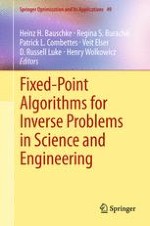2011 | OriginalPaper | Buchkapitel
Arbitrarily Slow Convergence of Sequences of Linear Operators: A Survey
verfasst von : Frank Deutsch, Hein Hundal
Erschienen in: Fixed-Point Algorithms for Inverse Problems in Science and Engineering
Verlag: Springer New York
Aktivieren Sie unsere intelligente Suche, um passende Fachinhalte oder Patente zu finden.
Wählen Sie Textabschnitte aus um mit Künstlicher Intelligenz passenden Patente zu finden. powered by
Markieren Sie Textabschnitte, um KI-gestützt weitere passende Inhalte zu finden. powered by
This is a survey (without proofs except for verifying a few new facts) of the slowest possible
rate of convergence
of a sequence of linear operators that converges
pointwise
to a linear operator. A sequence of linear operators (
L
n
) is said to converge to a linear operator
Larbitrarily slowly
(resp.,
almost arbitrarily slowly
) provided that (
L
n
) converges to
L
pointwise, and for each sequence of real numbers (ϕ(
n
)) converging to 0, there exists a point
x
=
x
ϕ
such that
$$\|{L}_{n}(x) - L(x)\| \geq \phi (n)$$
for all
n
(resp., for infinitely many
n
). Two main “lethargy” theorems are prominent in this study, and they have numerous applications. The first lethargy theorem (Theorem 11.16) characterizes almost arbitrarily slow convergence. Applications of this lethargy theorem include the fact that a large class of polynomial operators (e.g., Bernstein, Hermite–Fejer, Landau, Fejer, and Jackson operators) all converge almost arbitrarily slowly to the identity operator. Also all the classical quadrature rules (e.g., the composite Trapezoidal Rule, composite Simpson’s Rule, and Gaussian quadrature) converge almost arbitrarily slowly to the integration functional. The second lethargy theorem (Theorem 11.21) gives useful sufficient conditions that guarantee arbitrarily slow convergence. In the particular case when the sequence of linear operators is generated by the powers of a single linear operator, there is a “dichotomy” theorem (Theorem 11.27) which states that either there is linear (fast) convergence or arbitrarily slow convergence; no other type of convergence is possible. Some applications of the dichotomy theorem include generalizations and sharpening of (1) the von Neumann-Halperin cyclic projections theorem, (2) the rate of convergence for intermittently (i.e., “almost” randomly) ordered projections, and (3) a theorem of Xu and Zikatanov.
